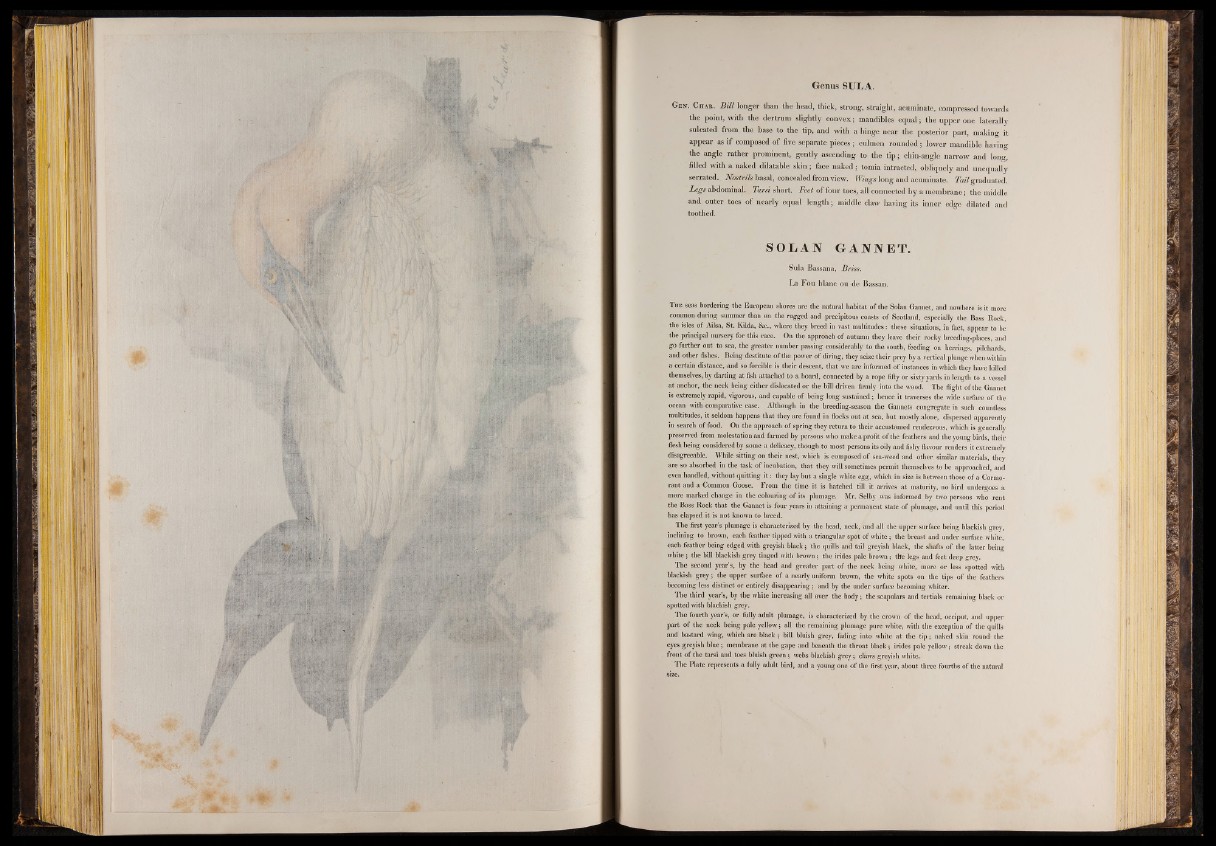
Genus STJLA.
G e n . Char. B i l l lo n g er th an th e head, th ick , stro n g , stra ig h t, acuminate, compressed towards
th e p o in t, w ith th e d e rtrum slig h tly co n v ex ; mandibles e q u a l; th e u p p e r one late ra lly
sulcated from th e base to th e tip , and w ith a hinge near, th e p o sterio r p a rt, mak in g it
a p p e a r as i f composed o f five separate p ie c e s ; culmen ro u n d e d ; low e r m andible having
th e an g le r a th e r p rom in en t, g e n tly ascending to th e t i p ; chin-angle n a rrow and long,
filled w ith a n ak ed d ilatab le s k in ; face n a k e d ; tomia in tra cted , o b liq u e ly and u n eq u a lly
serrated ,. N o s tr ils basal, concealed from view. Wings lo n g an d acuminate. T a il grad u ated .
L e g s abdominal. Tarsi short. Feet o f fo u r toes, a ll connected b y a m em b ran e ; th e middle
an d o u te r toes o f n e a rly e q u a l l e n g th ; m iddle claw h av in g its in n e r edge d ilated and
toothed.
SOLAN GANNET.
Sula Bassana, B riss.
La F ou blanc ou de Bassan.
T he seas bordering the European shores are the natural habitat of the Solan Gannet, and nowhere is it more
common during summer than on the rugged and precipitous coasts of Scotland, especially the Bass Rock,
the isles of Ailsa, St. Kilda, &c., where they breed in vast multitudes : these situations, in fact, appear to be
the principal nursery for this race. On the approach of autumn they leave their rocky breeding-places, and
go further out to sea, the greater number passing considerably to the south, feeding on herrings, pilchards,
and other fishes. Being destitute of the power of diving, they seize their prey by a vertical plunge when within
a certain distance, and so forcible is their descent, that we are informed of instances in which they have killed
themselves, by darting at fish attached to a board, connected by a rope fifty or sixty yards in length to a vessel
at anchor, the neck being either dislocated or the bill driven firmly into the wood. The flight of the Gannet
is extremely rapid, vigorous, and capable of being long sustained ; hence it traverses the wide surface of the
ocean with comparative ease. Although in the breeding-season the Gannets congregate in such countless
multitudes, it seldom happens that they are found in flocks out at sea, but mostly alone, dispersed apparently
in search of food. On the approach of spring they return to their accustomed rendezvous, which is generally
preserved from molestation and farmed by persons who make a profit of the feathers and the young birds, their
flesh being considered by some a delicacy, though to most persons its oily and fishy flavour renders it extremely
disagreeable. While sitting on their nest, which is composed of sea-weed and other similar materials, they
are so absorbed in the task of incubation, that they will sometimes permit themselves to be approached, and
even handled, without quitting it : they lay but a single white egg, which in size is between those o f a Cormorant
and a Common Goose. From the time it is hatched till it arrivés at maturity, no bird undergoes a
more marked change in the colouring of its plumage. Mr. Selby was informed by two persons who rent
the Bass Rock that the Gannet is four years in attaining a permanent state of plumage, and until this period
has elapsed it is not known to breed.
The first year’s plumage is characterized by the head, neck, and all the upper surface being blackish grey,
inclining to brown, each feather tipped with, a triangular spot of white ; the breast and under surface white,
each feather being edged with greyish black ; the quills and tail greyish black, the shafts of the latter being
white ; the bill blackish grey tinged with brown ; the irides pale brown ; the legs and feet deep grey.
The second year’s, by the head and greater part of the neck being white, more or less spotted with
blackish grey ; the upper surface of a nearly uniform brown, the white spots on the tips of the feathers
becoming less distinct or entirely disappearing ; and by the under surface becoming whiter.
The third year’s, by the white increasing all over the body ; the scapulars and tertials remaining black or
spotted with blackish grey.
The fourth year s, or fully adult plumage, is characterized by the crown of the head, occiput, and upper
part of the neck being pale yellow ; all the remaining plumage pure white, with the exception of the quills
and bastard wing, which are black ; bill bluish grey, fading into white at the tip ; naked skin round the
eyes greyish blue ; membrane at the gape and beneath the throat black ; irides pale yellow ; streak down the
front of the tarsi and toes bluish green ; webs blackish grey ; claws greyish white.
The Plate represents a fully adult bird, and a young one of the first year, about three fourths of the natural
size.